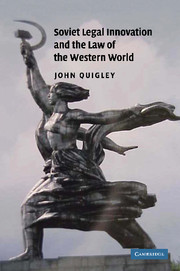Book contents
- Frontmatter
- Contents
- Abbreviations
- Preface
- Acknowledgments
- PART ONE THE SOVIET CHALLENGE
- PART TWO THE WEST ACCOMMODATES
- 8 Panic in the Palace
- 9 Enter the Working Class
- 10 Social Welfare Rights
- 11 The State and the Economy
- 12 Equality Comes to the Family
- 13 Child-Bearing and Rights of Children
- 14 Racial Equality
- 15 Crime and Punishment
- PART THREE THE BOURGEOIS INTERNATIONAL ORDER
- PART FOUR LAW BEYOND THE COLD WAR
- Notes
- Bibliography
- Index
12 - Equality Comes to the Family
Published online by Cambridge University Press: 27 July 2009
- Frontmatter
- Contents
- Abbreviations
- Preface
- Acknowledgments
- PART ONE THE SOVIET CHALLENGE
- PART TWO THE WEST ACCOMMODATES
- 8 Panic in the Palace
- 9 Enter the Working Class
- 10 Social Welfare Rights
- 11 The State and the Economy
- 12 Equality Comes to the Family
- 13 Child-Bearing and Rights of Children
- 14 Racial Equality
- 15 Crime and Punishment
- PART THREE THE BOURGEOIS INTERNATIONAL ORDER
- PART FOUR LAW BEYOND THE COLD WAR
- Notes
- Bibliography
- Index
Summary
The soviet insistence on the equality of women and men was not without consequence in the West. The Russian family code of 1918 had questioned the patriarchal character of Western family law. With the Bolshevik Revolution and the challenge issued by Soviet law as prods, Western governments gradually introduced elements of gender equality into domestic relations law. The twentieth century witnessed a fundamental change in legal regulation of the marital relationship and in gender roles in society.
Marriage and divorce, wrote Berman, became “largely a consensual matter, while parental power over children has been substantially reduced. As the family has been left more and more to its own devices, social relations of race and class and sex have been more and more subjected to legal restraint, in order to prevent exploitation.” These changes, wrote Berman, were “associated partly with the socialist movement.”
Governments intervened more forcefully in the family relationship; through administrative and criminal law they dealt with such problems as child neglect, or physical or sexual abuse within the family. Governments took responsibility, to a degree, for the well-being of the family. In Spain, a constitutional provision stated, “Public authorities shall assure the social, economic and legal protection of the family.”
In the years following the Bolshevik Revolution, European states gradually brought their family law statutes into line with indicated features of the 1918 Russian family code.
- Type
- Chapter
- Information
- Soviet Legal Innovation and the Law of the Western World , pp. 103 - 107Publisher: Cambridge University PressPrint publication year: 2007



